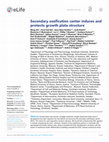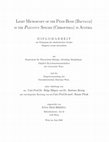Papers by Anna Nele Herdina

eLife
Growth plate and articular cartilage constitute a single anatomical entity early in development b... more Growth plate and articular cartilage constitute a single anatomical entity early in development but later separate into two distinct structures by the secondary ossification center (SOC). The reason for such separation remains unknown. We found that evolutionarily SOC appears in animals conquering the land - amniotes. Analysis of the ossification pattern in mammals with specialized extremities (whales, bats, jerboa) revealed that SOC development correlates with the extent of mechanical loads. Mathematical modeling revealed that SOC reduces mechanical stress within the growth plate. Functional experiments revealed the high vulnerability of hypertrophic chondrocytes to mechanical stress and showed that SOC protects these cells from apoptosis caused by extensive loading. Atomic force microscopy showed that hypertrophic chondrocytes are the least mechanically stiff cells within the growth plate. Altogether, these findings suggest that SOC has evolved to protect the hypertrophic chondroc...

Understanding cell types and mechanisms of dental growth is essential for reconstruction and engi... more Understanding cell types and mechanisms of dental growth is essential for reconstruction and engineering of teeth. Therefore, we investigated cellular composition of growing and nongrowing mouse and human teeth. As a result, we report an unappreciated cellular complexity of the continuously-growing mouse incisor, which suggests a coherent model of cell dynamics enabling unarrested growth. This model relies on spatially-restricted stem, progenitor and differentiated populations in the epithelial and mesenchymal compartments underlying the coordinated expansion of two major branches of pulpal cells and diverse epithelial subtypes. Further comparisons of human and mouse teeth yield both parallelisms and differences in tissue heterogeneity and highlight the specifics behind growing and nongrowing modes. Despite being similar at a coarse level, mouse and human teeth reveal molecular differences and species-specific cell subtypes suggesting possible evolutionary divergence. Overall, here we provide an atlas of human and mouse teeth with a focus on growth and differentiation.
Yearbook of Paediatric Endocrinology

Nature Communications
Understanding cell types and mechanisms of dental growth is essential for reconstruction and engi... more Understanding cell types and mechanisms of dental growth is essential for reconstruction and engineering of teeth. Therefore, we investigated cellular composition of growing and non-growing mouse and human teeth. As a result, we report an unappreciated cellular complexity of the continuously-growing mouse incisor, which suggests a coherent model of cell dynamics enabling unarrested growth. This model relies on spatially-restricted stem, progenitor and differentiated populations in the epithelial and mesenchymal compartments underlying the coordinated expansion of two major branches of pulpal cells and diverse epithelial subtypes. Further comparisons of human and mouse teeth yield both parallelisms and differences in tissue heterogeneity and highlight the specifics behind growing and non-growing modes. Despite being similar at a coarse level, mouse and human teeth reveal molecular differences and species-specific cell subtypes suggesting possible evolutionary divergence. Overall, her...

Scientific Reports
With global demand for SARS-CoV-2 testing ever rising, shortages in commercially available viral ... more With global demand for SARS-CoV-2 testing ever rising, shortages in commercially available viral transport media pose a serious problem for laboratories and health care providers. For reliable diagnosis of SARS-CoV-2 and other respiratory viruses, executed by Real-time PCR, the quality of respiratory specimens, predominantly determined by transport and storage conditions, is crucial. Therefore, our aim was to explore the reliability of minimal transport media, comprising saline or the CDC recommended Viral Transport Media (HBSS VTM), for the diagnosis of SARS-CoV-2 and other respiratory viruses (influenza A, respiratory syncytial virus, adenovirus, rhinovirus and human metapneumovirus) compared to commercial products, such as the Universal Transport Media (UTM). We question the assumptions, that the choice of medium and temperature for storage and transport affect the accuracy of viral detection by RT-PCR. Both alternatives to the commercial transport medium (UTM), HBSS VTM or salin...

PLOS ONE
Aims Mass antigen testing programs have been challenged because of an alleged insufficient specif... more Aims Mass antigen testing programs have been challenged because of an alleged insufficient specificity, leading to a large number of false positives. The objective of this study is to derive a lower bound of the specificity of the SD Biosensor Standard Q Ag-Test in large scale practical use. Methods Based on county data from the nationwide tests for SARS-CoV-2 in Slovakia between 31.10.–1.11. 2020 we calculate a lower confidence bound for the specificity. As positive test results were not systematically verified by PCR tests, we base the lower bound on a worst case assumption, assuming all positives to be false positives. Results 3,625,332 persons from 79 counties were tested. The lowest positivity rate was observed in the county of Rožňava where 100 out of 34307 (0.29%) tests were positive. This implies a test specificity of at least 99.6% (97.5% one-sided lower confidence bound, adjusted for multiplicity). Conclusion The obtained lower bound suggests a higher specificity compared ...

eLife
Growth plate and articular cartilage constitute a single anatomical entity early in development b... more Growth plate and articular cartilage constitute a single anatomical entity early in development but later separate into two distinct structures by the secondary ossification center (SOC). The reason for such separation remains unknown. We found that evolutionarily SOC appears in animals conquering the land - amniotes. Analysis of the ossification pattern in mammals with specialized extremities (whales, bats, jerboa) revealed that SOC development correlates with the extent of mechanical loads. Mathematical modeling revealed that SOC reduces mechanical stress within the growth plate. Functional experiments revealed the high vulnerability of hypertrophic chondrocytes to mechanical stress and showed that SOC protects these cells from apoptosis caused by extensive loading. Atomic force microscopy showed that hypertrophic chondrocytes are the least mechanically stiff cells within the growth plate. Altogether, these findings suggest that SOC has evolved to protect the hypertrophic chondroc...

Reliable diagnosis, executed by Real-Time PCR (RT-PCR), builds the current basis in SARS-CoV-2 co... more Reliable diagnosis, executed by Real-Time PCR (RT-PCR), builds the current basis in SARS-CoV-2 containment. Transport and storage conditions are the main indicators determining the quality of respiratory specimens. According to shortages in commercially available viral transport media, the primary aim of this study was to explore the reliability of minimal transport media including saline and CDC Viral Transport Media (HBSS VTM) composition for SARS-CoV-2 diagnosis by Real-time PCR compared to recommended commercially available standard Universal Transport Media (UTM). This study also implicated the stability of other respiratory viruses, including influenza A, respiratory syncytial virus, adenovirus, rhinovirus and human metapneumovirus, providing further evidence for future recommendations on transport and storage of respiratory viruses. Both viral transport media (self-made HBSS VTM and UTM) and saline (0.9% NaCl) allow adequate detection of SARS-CoV-2 and other respiratory virus...

Biology Open
The Deciphering the Mechanisms of Developmental Disorders (DMDD) program uses a systematic and st... more The Deciphering the Mechanisms of Developmental Disorders (DMDD) program uses a systematic and standardised approach to characterise the phenotype of embryos stemming from mouse lines, which produce embryonically lethal offspring. Our study aims to provide detailed phenotype descriptions of homozygous Col4a2 em1(IMPC)Wtsi mutants produced in DMDD and harvested at embryonic day 14.5. This shall provide new information on the role Col4a2 plays in organogenesis and demonstrate the capacity of the DMDD database for identifying models for researching inherited disorders. The DMDD Col4a2 em1(IMPC)Wtsi mutants survived organogenesis and thus revealed the full spectrum of organs and tissues, the development of which depends on Col4a2 encoded proteins. They showed defects in the brain, cranial nerves, visual system, lungs, endocrine glands, skeleton, subepithelial tissues and mild to severe cardiovascular malformations. Together, this makes the DMDD Col4a2 em1(IMPC)Wtsi line a useful model for identifying the spectrum of defects and for researching the mechanisms underlying autosomal dominant porencephaly 2 (OMIM # 614483), a rare human disease. Thus we demonstrate the general capacity of the DMDD approach and webpage as a valuable source for identifying mouse models for rare diseases.

The growth of long bones occurs in narrow discs of cartilage, called growth plates that provide a... more The growth of long bones occurs in narrow discs of cartilage, called growth plates that provide a continuous supply of chondrocytes subsequently replaced by newly formed bone tissue. These growth plates are sandwiched between the bone shaft and a more distal bone structure called the secondary ossification center (SOC). We have recently shown that the SOC provides a stem cell niche that facilitates renewal of chondro-progenitrors and bone elongation. However, a number of vertebrate taxa, do not have SOCs, which poses intriguing questions about the evolution and primary function of this structure. Evolutionary analysis revealed that SOCs first appeared in amniotes and we hypothesized that this might have been required to meet the novel mechanical demands placed on bones growing under weight-bearing conditions. Comparison of the limbs of mammals subjected to greater or lesser mechanical demands revealed that the presence of a SOC is associated with the extent of these demands. Mathema...

American Journal of Human Biology
The narrow human birth canal evolved in response to multiple opposing selective forces on the pel... more The narrow human birth canal evolved in response to multiple opposing selective forces on the pelvis. These factors cannot be sufficiently disentangled in humans because of the limited range of relevant variation. Here, we outline a comparative strategy to study the evolution of human childbirth and to test existing hypotheses in primates and other mammals. Methods: We combined a literature review with comparative analyses of neonatal and female body and brain mass, using three existing datasets. We also present images of bony pelves of a diverse sample of taxa. Results: Bats, certain non-human primates, seals, and most ungulates, including whales, have much larger relative neonatal masses than humans, and they all differ in their anatomical adaptations for childbirth. Bats, as a group, are particularly interesting in this context as they give birth to the relatively largest neonates, and their pelvis is highly dimorphic: Whereas males have a fused symphysis, a ligament bridges a large pubic gap in females. The resulting strong demands on the widened and vulnerable pelvic floor likely are relaxed by roosting head-down. Conclusions: Parturition has constituted a strong selective force in many nonhuman placentals. We illustrated how the demands on pelvic morphology resulting from locomotion, pelvic floor stability, childbirth, and perhaps also erectile function in males have been traded off differently in mammals, depending on their locomotion and environment. Exploiting the power of a comparative approach, we present new hypotheses and research directions for resolving the obstetric conundrum in humans.

Even though little information is available on its microanatomy or function, the baculum (penis b... more Even though little information is available on its microanatomy or function, the baculum (penis bone) is used in bat species identification. In the present study, the bacula of Plecotus auritus (n = 5), Plecotus macrobullaris (n = 4) and Plecotus austriacus (n = 11) were investigated by light microscopy after various preservation and fixation procedures. The Y-shaped baculum was identified in the tip of the penis using micro CTs and specimen microradiographs. Histologically, the types of bone and other tissues constituting the baculum were examined on serial semithin sections and on surface-stained, undecalcified ground sections. 3D-reconstructions were generated from the serial semithin sections and the micro CT image slices. Microscopically the baculum shows differences in shape and dimensions (total lengthx: 1.16 mm in P. auritus, 0.83 mm in P. macrobullaris and 0.81 mm in P. austriacus), suitable for differentiation of these three Plecotus species. The proximal branches and the shaft of the baculum form a tubular bone with mainly lamellar structure. Since it contains no longitudinal Haversian canals, the baculum equals a single osteon bone. Several oblique nutrient canals enter the medullary cavity of the shaft and branches. Number and distribution of the nutrient canals are different in the three species. All three ends of the baculum consist of more woven bone. The tunica albuginea of the corpora cavernosa continues into the periosteum of the baculum, and collagen fiber bundles insert via fibrocartilage into the woven bone of the branches. The microscopic structures imply the function of the baculum as a stiffening element in the functional unit of the erected penis. Specimen microradiography and, even better, micro CT proved to be suitable non-invasive methods for the accurate and reproducible demonstration and comparison of the three-dimensional structures of the baculum in different bat species. KURZFASSUNG Das Baculum (Penisknochen) wird zur Artbestimmung bei Fledermäusen genutzt, obwohl wenigüber seine Mikroanatomie oder Funktion bekannt ist. In der vorliegenden Arbeit wurden die Bacula von Plecotus auritus (n = 5), Plecotus macrobullaris (n = 4) und Plecotus austriacus (n = 11), die zuvor auf verschiedene Arten fixiert und aufbewahrt wurden, lichtmikroskopisch untersucht. Das Y-förmige Baculum wurde mithilfe von Mikro CT und Mikroradiographie in der Penisspitze lokalisiert. Die Arten von Knochen-und anderen Geweben aus denen das Baculum aufgebaut ist, wurden an Semidünnschnitt-Serien und unentkalkten Dünnschliffen histologisch untersucht. 3D-Rekonstruktionen wurden anhand von Semidünnschnitt-Serien und Mikro CT Bildserien erstellt. Im mikroskopischen Bereich zeigt das Baculum in Form und Abmessungen Unterschiede (Gesamtlängex: 1,16 mm in P. auritus, 0,83 mm in P. macrobullaris und 0,81 mm in P. austriacus), die eine Artbestimmung dieser drei Plecotus Arten ermöglichen. Die proximalenÄste und der Schaft des Baculums bilden einen Röhrenknochen mit großteils lamellärer Struktur. Da es keine längsgerichteten Haverschen Kanäle enthält, entspricht das Baculum einem großen Osteon, also einem Knochen aus einem einzelnen Haverschen System. Einige versorgende Gefäße gelangenüber schräge Nährkanälchen in den Markraum. Alle drei Enden des Baculums bestehen mehrheitlich aus Geflechtknochen. Die Tunica albuginea der Schwellkörper setzt sich nahtlos in das Periost des Baculums fort und Collagen-Faserbündel inserieren via Faserknorpel in den Geflechtknochen derÄste. Die mikroskopischen Strukturen weisen auf eine Funktion des Baculums als versteifendes Element in der funktionellen Einheit des erigierten Penis hin. Die Mikroradiographie ganzer Penes und, besser noch, das Mikro CT erwiesen sich als geeignete, nicht invasive Methoden zur genauen, wiederholbaren und vergleichbaren Darstellung der dreidimensionalen Strukturen des Baculums verschiedener Fledermausarten.

Journal of anatomy, Jun 11, 2016
Morphologists have historically had to rely on destructive procedures to visualize the three-dime... more Morphologists have historically had to rely on destructive procedures to visualize the three-dimensional (3-D) anatomy of animals. More recently, however, non-destructive techniques have come to the forefront. These include X-ray computed tomography (CT), which has been used most commonly to examine the mineralized, hard-tissue anatomy of living and fossil metazoans. One relatively new and potentially transformative aspect of current CT-based research is the use of chemical agents to render visible, and differentiate between, soft-tissue structures in X-ray images. Specifically, iodine has emerged as one of the most widely used of these contrast agents among animal morphologists due to its ease of handling, cost effectiveness, and differential affinities for major types of soft tissues. The rapid adoption of iodine-based contrast agents has resulted in a proliferation of distinct specimen preparations and scanning parameter choices, as well as an increasing variety of imaging hardwa...

Even though little information is available on its microanatomy or function, the baculum (penis b... more Even though little information is available on its microanatomy or function, the baculum (penis bone) is used in bat species identification. In the present study, the bacula of Plecotus auritus (n = 5), Plecotus macrobullaris (n = 4) and Plecotus austriacus (n = 11) were investigated by light microscopy after various preservation and fixation procedures. The Y-shaped baculum was identified in the tip of the penis using micro CTs and specimen microradiographs. Histologically, the types of bone and other tissues constituting the baculum were examined on serial semithin sections and on surface-stained, undecalcified ground sections. 3D-reconstructions were generated from the serial semithin sections and the micro CT image slices. Microscopically the baculum shows differences in shape and dimensions (total lengthx: 1.16 mm in P. auritus, 0.83 mm in P. macrobullaris and 0.81 mm in P. austriacus), suitable for differentiation of these three Plecotus species. The proximal branches and the shaft of the baculum form a tubular bone with mainly lamellar structure. Since it contains no longitudinal Haversian canals, the baculum equals a single osteon bone. Several oblique nutrient canals enter the medullary cavity of the shaft and branches. Number and distribution of the nutrient canals are different in the three species. All three ends of the baculum consist of more woven bone. The tunica albuginea of the corpora cavernosa continues into the periosteum of the baculum, and collagen fiber bundles insert via fibrocartilage into the woven bone of the branches. The microscopic structures imply the function of the baculum as a stiffening element in the functional unit of the erected penis. Specimen microradiography and, even better, micro CT proved to be suitable non-invasive methods for the accurate and reproducible demonstration and comparison of the three-dimensional structures of the baculum in different bat species.





Uploads
Papers by Anna Nele Herdina